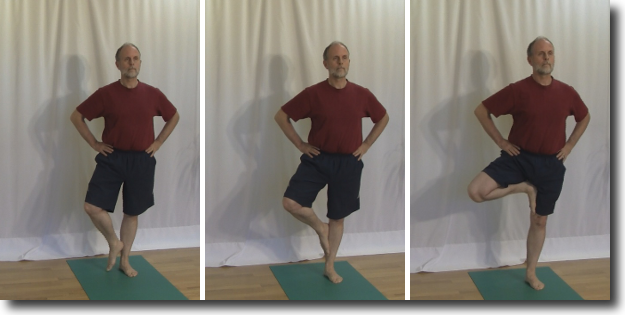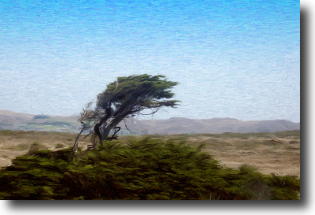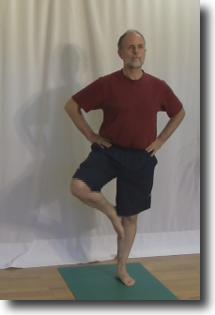The wind is blowing hard. The tree has been through this many times before. It continues to stand tall with its branches spreading far into the air. It would only move slightly back and forth as the wind blew hard and harder.
There may be no wind blowing in Alice’s yoga class to challenge her when she does Tree pose, but she is finding it a challenge to get her foot off of the floor and stay balanced.
What is Tree Pose
Tree pose is the common English name for this pose. Its Sanskrit name is Vrksasana (pronounced – vrik-SHAHS-anna). Vrksa is Sanskrit for tree.
The pose looks like a tree when you have your hands on your hips with your elbows spread wide or when you have your arms up over your head with either your palms together or spread wide apart.
Tree pose is one of many standing poses. This pose emphasizes balance and core strength. Tree pose is a fairly straight forward pose to do. There is no binding, twisting or folding in this pose.
How to do Tree pose
You enter this pose from Tadasana. You are standing tall with your feet together, your arms by your side and you are gazing to the horizon.
From here as you start to inhale, you turn your right leg out to the side, bend your knee and lift your right foot off of the mat.
Lift your right foot as far up your left leg as possible and bring your foot firmly against your left leg. Eventually your right foot will be at the top of your leg with your heel pressing into your groin, the sole of your foot pressing into your thigh and your toes pointing down towards the mat.
At the same time that you are lifting your leg and bringing your right foot against your left thigh, bring your hands to the top of your hips with the thumbs to the back and your arms bent out to the side away from the body.
Finally you bring your gaze to the horizon and hold here for several breaths.
Once you have completed the pose with the right leg, you repeat the pose with the left foot resting on your right thigh.
Alice is struggling in two areas with this pose. She is having a hard time getting her right foot high up her left leg and she is finding balancing difficult. While this pose is surprisingly difficult for Alice, she is getting some benefit from the pose.
Why do tree pose
Vrksasana or Tree pose has many benefits. It will help Alice to strengthen her leg muscles. Her ankle, calf and thigh muscles will get stronger as a result.
This pose stretches the inner thighs and the muscles around the hips. The more flexibility you get in your hip and thigh muscles the more external rotation there will be in your leg and the higher your foot will come to rest on your standing leg.
Tree pose also improves your sense of balance. In the beginning your balance may be terrible but over time as your abdominal muscles strengthen you will find your balance improves.
This pose also helps to relieve Sciatica pain and reduces flat feet.
There are a few challenging areas with this pose and Alice is suffering with both of them. She can only get her foot part way up her leg.
What do you do if you can’t get your foot up into your groin?

The three stages of Tree pose – Sapling, Young tree and Mature tree. As you flexibility improve your tree will mature.
Even though this is an easy pose to do a lot of people have a challenge getting there right foot into their left groin. In fact this is a good pose to work on developing the required flexibility in your hip. As your flexibility in your hip improves your foot will travel up your leg and go through the many stages of a tree’s life.
Sapling stage
You start out by turning your right leg out to the side and lifting your right foot off of the floor and placing it against your left leg.
In the beginning or the sapling stage your right foot is slightly off of the floor and it is resting against your leg just above your ankle. You may need to occasionally touch your toe to the floor to help with your balance.
Usually you do not stay in this stage for very long. As flexibility in your hip improves you move on to the young tree stage.
Young tree
In the young tree stage your right foot has moved up your left leg and is pressing into your calf or thigh muscle either above or below your knee. It is a long journey from your ankle to the top of your hip and as a result you stay in this stage for a while but eventually you do move on to the final stage, the mature tree stage.
Mature tree
In this stage your right foot has completed its journey up your leg and is pressing firmly into the groin of your left leg. This is the final stage. Your right foot has reached its destination.
In this journey from sapling to mature tree there is one point of danger you must avoid. You need to avoid pressing into your knee.
Avoid placing your foot against your knee
As you move your foot up your leg, in the young tree stage, you must avoid pressing your heel into your knee. If you do this you will be pushing your knee out to the side. Your knee is an unstable joint when it has pressure applied from the side and you can easily injure it.
When your heel reaches your knee during the young tree stage of the pose you need to move it completely above your knee. You can use your hands to help lift your foot that little bit extra to get your foot above your knee.
Alice is in the young tree stage with her foot just above her knee but she is finding balancing in the pose a real challenge.
Balance challenge
Watching Alice it appears as though there is a strong breeze blowing through the room. She is bending all over the place just like a young tree in a strong wind.
There are a few things that Alice can do to bring some stability to the pose.
Engage abdominal muscles
Alice can use the muscles of her core to bring some stability to the pose. Her arms on her hips can help her as well. Pressing her hands firmly into the top of her hips will help to engage more muscles in her core and this will help to stabilize her body.
There is one more thing that Alice can do if she is still wobbling after engaging her core muscles.
Touch the wall
Alice can move close to one of the walls and use it as an assist with her balance. Touching the wall lightly with an elbow will help reduce the wobbling and bring stability to the pose. Over time as her core muscles strengthen, Alice can reduce the amount of pressure and the duration that her elbow is touching the wall.
Summary
Alice has been able to get her foot to rest higher on her thigh and today she has become a mature tree with her right heel pressed firmly into her groin. Now as long as there is no strong breeze in the yoga studio she will keep her balance and successfully finish the pose.
Next Step
Ask your yoga teacher to help you with the placement and alignment of your foot on your standing leg. Be sure to avoid placing pressure on the side of your knee as you journey from sapling to mature tree in this pose.






